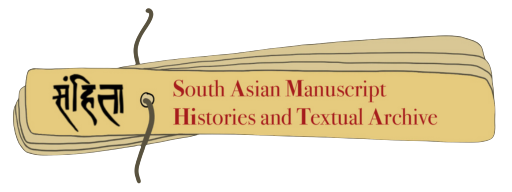Manuscripts
Search Filter
Jaiminīya-Nyāyamālāvistara
EAP1023/17/5 Language : Sanskrit Scripts : Devanagari
It is a Mimamsha Shastra divided into twelve chapters. It is an important work on philosophy by Madhavacharya.
Caraṇavyūha
EAP1023/17/2 Language : Sanskrit Scripts : Devanagari
Charana Vyuha or the ‘Exposition of the Schools’ of various Vedas , is a late work giving less complete enumeration of the Vedic schools than certain sections of Vishnu and Vayu Purana [Viṣṇupurāṇa and Vāyupurāṇa].
Yogasūtra
EAP1023/17/4 Language : Sanskrit Scripts : Devanagari
This manuscript is the fourth section or chapter of Patanjali Yoga Sutra. This chapter is Named as Kaivalyapada. It is about the finalliberation. It forms the foundation of classical yoga philosophy.
Pītāmbarasahasranāmastotra
EAP1023/17/1 Language : Sanskrit Scripts : Devanagari
Bagalamukhi is known by the popular epithet Pitambara-devi or Pitambari. She wears yellow clothes. The iconography and worship rituals repeatedly refer to the yellow colour. Pitamvara Sahasranama Stotra is the eulogy of Baglamukhi.This text is Bagalamukhi Stotra that recites.
Rasamaňjarī
EAP1023/28/8 Language : Sanskrit Scripts : Devanagari
Sanskrit classic Rasamanjari, a long poem with epical stretch but not an epic, is a work by the known Sanskrit poet Bhanudatta. It is a 15th century text on Indian aesthetics. This is an erotic text. Rasamanjari literally refers to the cluster of blossoms full of Rasas. It is one of the most inspiring texts of ancient India that prompted various schools of Indian painting.
Tristhalīsetu
EAP1023/28/5 Language : Sanskrit Scripts : Devanagari
This is text known as Marana Mukti Vichara in Sanskrit. Literally, it is idea of liberation after death. It is written by Narayana Bhatta. This is the Gaya Prakarana section of the text.
Laghusiddhāntakaumudī
EAP1023/28/6 Language : Sanskrit Scripts : Devanagari
Laghusiddhāntakaumudī by Varadarāja (1600-1650) son of Durgātanaya, disciple of Bhaṭṭoji Dīkṣita. From its title it is easy to understand that this text was wrote as an elementary text for Sanskrit learners.
Vidhānapārijāta
EAP1023/28/3 Language : Sanskrit Scripts : Devanagari
This text is the book of marriage rituals. This is the second chapter of the text.
Vidhānapārijāta
EAP1023/28/2 Language : Sanskrit Scripts : Devanagari
This text is the book of marriage rituals. This is the third chapter of the text.
Bṛhatsaṃhitā
EAP1023/25/53 Language : Sanskrit Scripts : Devanagari
Vrihat Samhita is authored by Varaha Mihira. The Brihat-Samhita by Varaha Mihira is an encylopedia of wide ranging subjects of human interest, including astrology, planetary movements, eclipses, rainfall, clouds, architecture, growth of crops, matrimony, domestic relations, gems, pearls and rituals. It contains one hundred and six chapters. This text is the Magnum Opus of Varaha Mihira.
Dānamayūkha
EAP1023/25/52 Language : Sanskrit Scripts : Devanagari
Dana Mayukha is authored by Nilakantha Bhatta. It is one of his twelve Mayukhas. Mayukha literally means 'Ray of Light'. The twelve Mayukhas of Nilakantha Bhatta are Samskara Mayukha, Acara Mayukha, Samaya Mayukha, Suddhi Mayukha, Niti Mayukha, Vyavahara Mayukha, Dana Mayukha, Utsarga Mayukha, Pratistha Mayukha, Shraddha Mayukha, Prayaschitta Mayukha, and Shanti Mayukha.
Kriyā Yoga Sāra
EAP1023/25/50 Language : Sanskrit Scripts : Devanagari
The Kriya Yoga Sara is always considered as a sort of supplement to the Padma Purana, or as a portion of the Uttara Khanda of that Purana. It is divided into twenty five chapters and 4000 stanzas.













